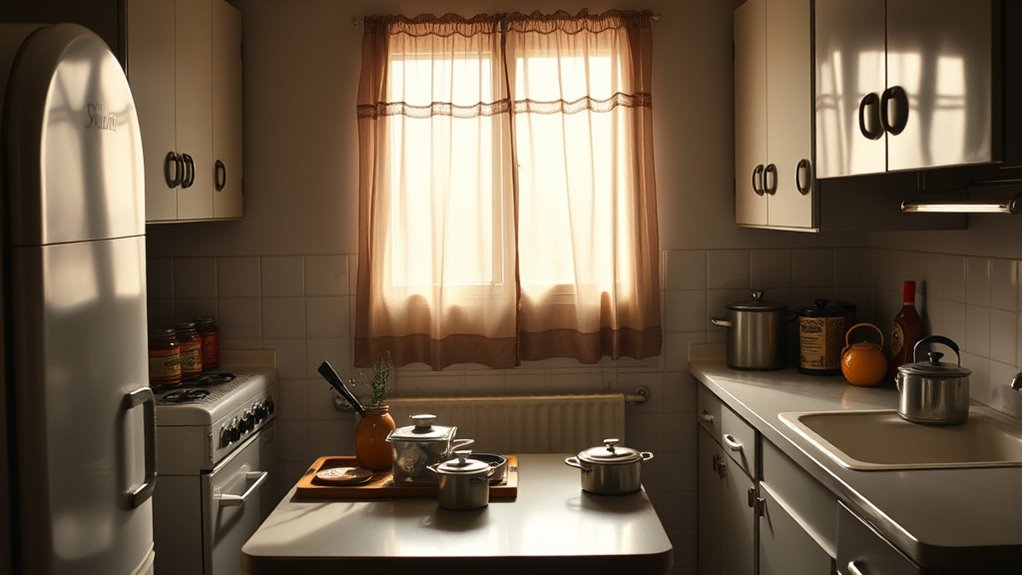World War II changed your kitchen forever by inspiring new designs focused on efficiency, safety, and sustainability. Supply shortages led to simpler, multifunctional appliances, while innovations like microwaves and improved stoves made cooking faster and safer. Hygiene standards increased, making kitchens cleaner and safer. Post-war economic growth meant more appliances and stylish, space-saving layouts. These wartime influences still shape your modern kitchen’s eco-friendly features and streamlined organization—continue exploring to discover how history transformed your cooking space.
Key Takeaways
- Wartime resource shortages led to minimalist, multifunctional kitchen designs emphasizing efficiency and material conservation.
- Technological advances during WWII accelerated the development of appliances like microwave ovens and efficient gas stoves.
- Enhanced safety and hygiene standards introduced antimicrobial surfaces, automatic sinks, and strict sanitation protocols.
- Post-war economic growth increased appliance adoption, favoring sleek, practical kitchen designs and innovative household tools.
- Wartime innovations in recycled materials and ergonomic design continue to influence eco-friendly and user-friendly kitchen trends today.
Resource Scarcity and Its Impact on Kitchen Design
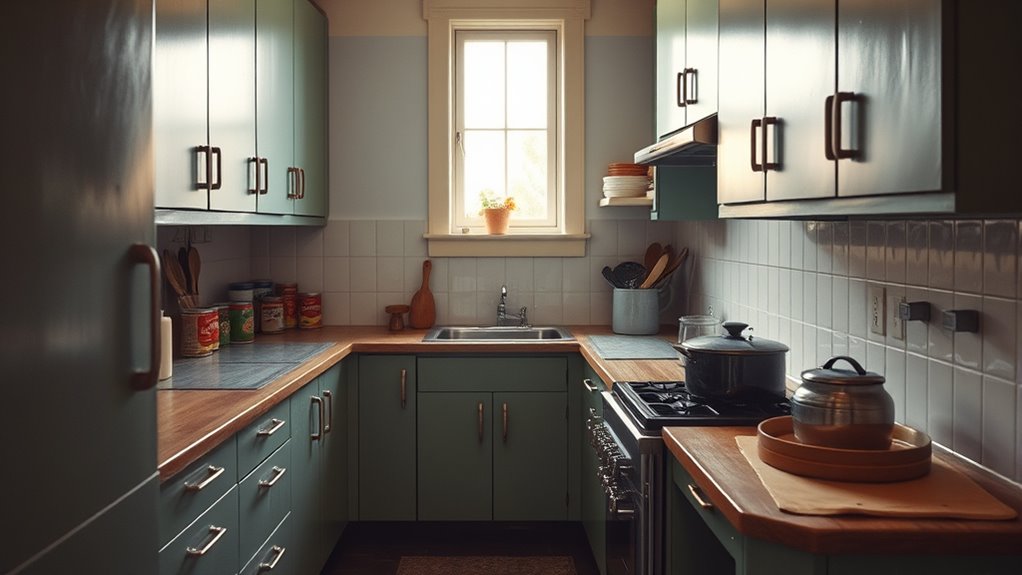
During World War II, resource scarcity forced homeowners and designers to rethink kitchen layouts and materials. Supply chain disruptions made it difficult to access traditional building supplies and appliances. As a result, rationing strategies became essential, limiting the use of certain materials like metals, wood, and plastics. This forced a shift toward simpler, more efficient designs that used fewer resources. You might notice that kitchens from this era feature streamlined cabinetry and multifunctional fixtures, reflecting the need to maximize utility with minimal supplies. The focus shifted to conserving materials without sacrificing functionality. This period taught designers to innovate within constraints, laying the groundwork for modern minimalist approaches that emphasize efficiency and sustainability. Additionally, the adoption of alternative technologies helped optimize resource use and reduce waste during this challenging time.
Innovations in Cooking Appliances During Wartime

During World War II, new cooking appliances emerged to meet wartime needs. You’ll see how the microwave oven was developed, along with improvements to gas stoves and portable devices. These innovations transformed home kitchens and influenced modern cooking techniques. Additionally, the use of essential oils in kitchen and health practices began to gain popularity, reflecting a broader interest in natural remedies and wellness.
Microwave Oven Development
The development of microwave ovens was markedly accelerated by wartime innovations, as scientists and engineers sought new ways to improve communication and radar technology. These advances led to the discovery of microwave radiation’s cooking potential, transforming how you prepare food. During this period, engineers focused on miniaturizing components, making appliances more practical for household use. As a result, cooking habits shifted toward faster, more convenient methods, changing kitchen routines forever. The design of microwave ovens also evolved, emphasizing appliance aesthetics that blend seamlessly into modern kitchens. Today, you see sleek, user-friendly devices that prioritize both function and style. Wartime innovations laid the groundwork for this revolution, enabling you to cook quickly without sacrificing visual appeal or efficiency. Additionally, the integration of best laundry detergents into appliance design has further enhanced cleaning efficiency and convenience in your daily routines.
Gas Stove Improvements
Wartime demands spurred significant innovations in gas stove technology, leading to more efficient, safe, and durable appliances. During this period, engineers focused on gas stove improvements to maximize fuel efficiency, essential for conserving resources. You’ll find that new burner designs provided better heat control and reduced waste, making cooking faster and more reliable. Safety features also advanced, with improved flame control and automatic shut-offs to prevent accidents. Durability increased as materials were strengthened to withstand heavy use amid shortages. These innovations not only addressed wartime needs but also laid the groundwork for modern kitchen appliances. Additionally, adherence to safety standards and regulations became more prominent, ensuring that appliances met essential safety criteria. Today’s gas stoves owe much to these wartime improvements, which prioritized efficiency and safety, transforming everyday cooking experiences into safer, more efficient tasks.
Portable Cooking Devices
Innovations in gas stove technology during wartime didn’t just improve stationary appliances; they also paved the way for portable cooking devices that could meet the demands of mobile life and resource constraints. During this period, portable burners and mobile stoves became essential for soldiers and civilians alike. These devices were lightweight, easy to transport, and designed to operate efficiently with limited fuel supplies. They allowed you to cook meals wherever you were, whether in field camps or cramped shelters. The focus was on simplicity, durability, and adaptability. As a result, modern portable cooking devices owe much to wartime innovations, transforming how you prepare food on the go. Today’s camping stoves and portable burners trace their roots directly to these wartime advancements. Portable cooking devices became a crucial element of wartime innovation, emphasizing portability and resource efficiency.
The Rise of Safety and Hygiene Standards in Kitchens
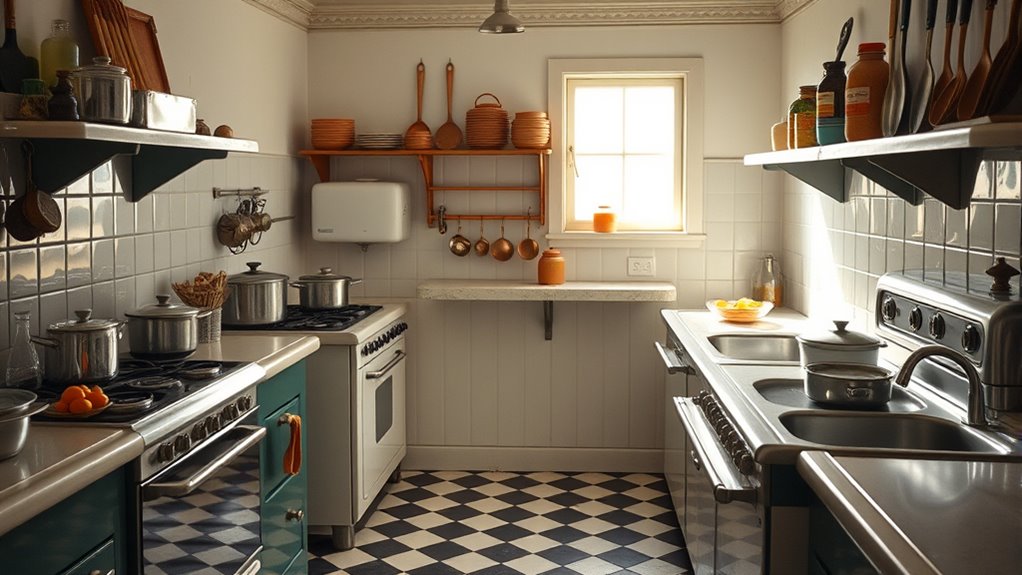
During World War II, safety and hygiene in kitchens became a top priority. You start to see improved sanitization practices, protective equipment, and strict food handling protocols. These changes laid the foundation for the modern standards you follow today. Additionally, the introduction of performance kits for appliances and better airflow systems contributed to more efficient and safer kitchen environments.
Enhanced Sanitization Practices
The heightened awareness of health risks has led kitchens around the world to adopt stricter sanitization practices. You now prioritize cleanliness with innovations like antimicrobial surfaces that inhibit bacterial growth. Disinfectant technology has advanced, making it easier to eliminate germs effectively. Kitchens feature easily sanitized countertops and cutting boards, reducing cross-contamination. Regular use of powerful disinfectants ensures a safer environment, especially in high-touch areas. You’re also likely to see touchless soap dispensers and automatic sinks, minimizing contact and spreading germs. These practices create a hygienic space where food safety is paramount, reflecting the influence of wartime innovations. Enhancing sanitation isn’t just about cleanliness; it’s about protecting health and preventing illness in every modern kitchen.
Use of Protective Equipment
As safety and hygiene standards have become more critical in modern kitchens, the use of protective equipment has grown substantially. You now rely on protective gear like gloves, aprons, and eye protection to prevent contamination and injuries. Safety protocols emphasize wearing the right gear during food preparation and handling, reducing risks from sharp tools or hot surfaces. These measures help safeguard both your health and the cleanliness of the kitchen environment. You’re encouraged to follow strict guidelines, ensuring protective equipment is worn consistently and correctly. This shift toward safety practices stems from lessons learned during World War II, where hygiene and worker safety became top priorities. Incorporating protective gear into daily routines has been proven to significantly reduce accidents and improve overall kitchen hygiene. Today, protective gear isn’t just recommended; it’s an essential part of maintaining a safe, hygienic kitchen.
Strict Food Handling Protocols
Strict food handling protocols have become the foundation of modern kitchen safety, ensuring that hygiene is maintained at every step. You now follow precise procedures to prevent contamination and ensure food safety. These standards include proper handwashing, sanitizing surfaces, storing ingredients correctly, and avoiding cross-contamination. By adhering to hygiene standards, you reduce the risk of foodborne illnesses and promote a clean environment. Kitchen staff are trained regularly on safety protocols, emphasizing the importance of cleanliness. Clear guidelines help maintain consistency and accountability. As a result, consumers trust the safety of their food and enjoy healthier meals. These protocols reflect the influence of wartime safety measures, shaping today’s emphasis on hygiene and food safety in every modern kitchen. Understanding the importance of Gold IRA Rollovers can also help diversify your investment portfolio for long-term security.
Technological Advancements Driven by Wartime Needs

Wartime shortages and urgent logistical needs have historically spurred rapid technological innovations, and this pattern holds true during World War II. As resources became scarce, inventors and engineers developed new appliances to maximize efficiency in kitchens. Cultural influences and culinary traditions also shaped these innovations, reflecting diverse cooking styles and preferences. For example, the need for quick meal preparation led to the creation of electric appliances like toasters and mixers, transforming traditional cooking methods. Wartime research accelerated the development of more durable, space-saving kitchen tools, which later influenced modern appliances. These advancements made cooking faster and more efficient, ultimately shaping the design and functionality of today’s kitchens. The war’s technological push not only addressed immediate needs but also laid the foundation for post-war culinary innovations.
The Role of Women and Changing Social Dynamics
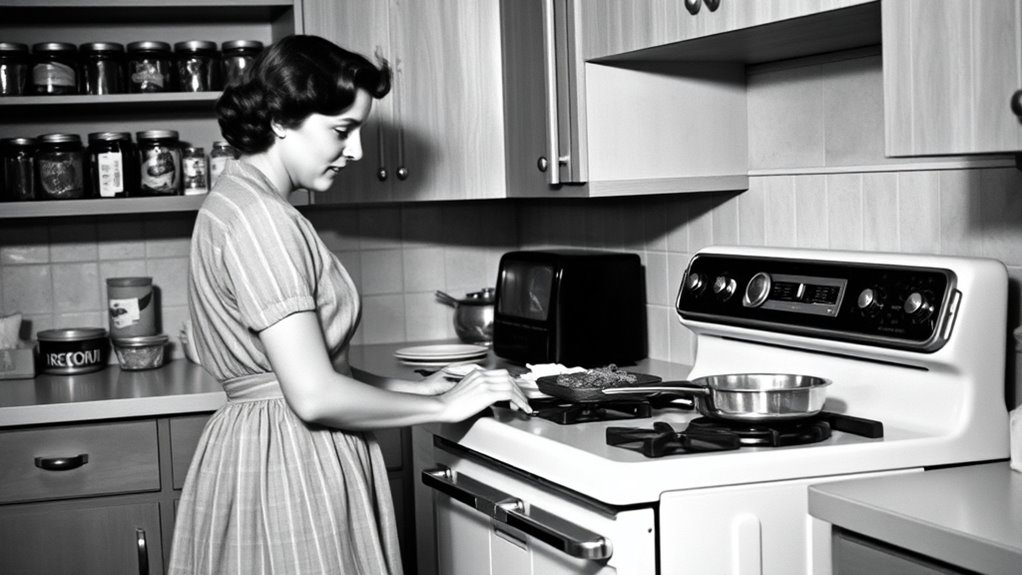
How did World War II reshape the roles women played in the kitchen and society? During this period, women’s roles expanded beyond traditional boundaries, reflecting significant social change. With many men at war, women stepped into new responsibilities at work and home, becoming symbols of resilience and independence. This shift influenced domestic life and kitchen design, emphasizing efficiency and practicality. You can imagine women managing household tasks while balancing new jobs, breaking stereotypes. The social change fostered a sense of empowerment, encouraging more participation in public life. Women’s roles evolved from solely homemakers to active contributors in wartime efforts and beyond. This transformation laid the groundwork for future gender equality movements, fundamentally altering societal expectations around women’s capabilities and influence. Additionally, the increased involvement of women in various sectors led to a reevaluation of household routines and kitchen organization, promoting smarter and more efficient culinary spaces.
Post-War Economic Growth and Consumer Appliance Adoption
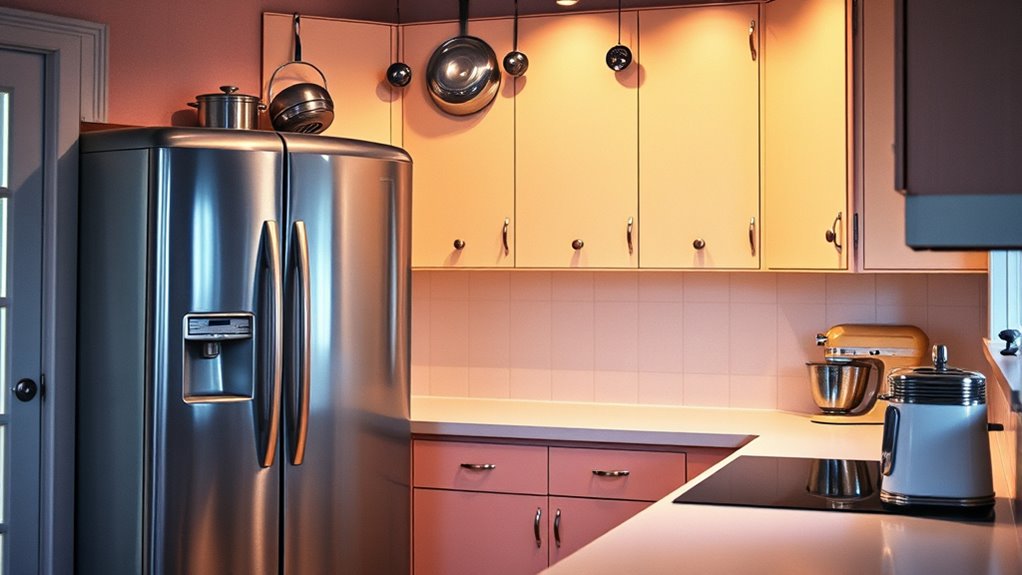
After the war ended, the economy experienced rapid growth, transforming everyday life and household routines. As incomes increased, more families could afford consumer appliances, making cooking and cleaning easier. This surge in purchasing power led to widespread adoption of modern appliances, such as refrigerators, ovens, and dishwashers, which became staples in many homes. Vintage cookware gained popularity, reflecting a nostalgic appreciation for traditional kitchen tools amid new innovations. Kitchen aesthetics also shifted, emphasizing sleek designs and functional layouts that combined style with practicality. You now notice how these changes made kitchens more efficient and visually appealing, encouraging you to invest in appliances that modernized your space. Additionally, the rise of consumer confidence led to increased spending on home improvement and appliance upgrades, shaping the modern kitchen landscape. The post-war economic boom truly shaped the way you experience daily cooking and household management.
The Evolution of Space Efficiency and Storage Solutions

As kitchens became more integrated into daily life, designers and homeowners began prioritizing space efficiency and smarter storage solutions to maximize functionality. You’ll notice how compact storage options, like pull-out cabinets and hidden compartments, help you utilize every inch. Modular designs allow you to customize your kitchen layout, adapting to your needs and making the most of limited space. These innovations make your cooking area more organized and accessible.
- Sliding shelves that maximize corner spaces
- Fold-away countertops for extra workspace
- Stackable containers for easy storage
- Hidden drawers in appliances for small items
Legacy of Wartime Innovation in Modern Kitchen Trends

Many modern kitchen innovations directly trace their roots back to wartime inventions, which transformed everyday appliances and storage solutions. During the war, engineers prioritized efficiency and durability, leading to the adoption of sustainable materials like recycled metals and plastics. These materials continue to influence eco-friendly trends today. Wartime innovations also emphasized ergonomic design, making appliances easier and safer to use. This focus has persisted, resulting in kitchens that prioritize comfort, accessibility, and user-friendly layouts. As a result, you benefit from appliances that are not only environmentally conscious but also ergonomically optimized, reducing strain and increasing usability. The wartime drive for innovation laid the groundwork for sustainable, ergonomic kitchens that blend functionality with modern environmental concerns.
Frequently Asked Questions
How Did Wartime Rationing Influence Home Cooking Habits?
Wartime rationing profoundly impacted home cooking habits by forcing you to adapt and be more resourceful with limited ingredients. The rationing impact made you focus on meal planning, using substitutes, and conserving supplies. You learned to cook creatively with less, which led to smarter shopping and meal prep habits. This shift in home cooking fostered a sense of ingenuity and resilience that influenced post-war culinary practices.
What Materials Used During Wartime Are Still Found in Modern Appliances?
You’ll notice that many modern appliances still feature materials like stainless steel and durable plastics, which originated during wartime shortages. These sustainable materials are prized for their longevity and eco-friendliness. Additionally, vintage design elements such as retro-style knobs or handles often incorporate wartime-inspired aesthetics, blending classic charm with modern functionality. By using these materials and design cues, manufacturers honor past innovations while prioritizing sustainability and timeless appeal in today’s kitchens.
How Did Military Kitchen Designs Inspire Civilian Kitchen Layouts?
Think of your kitchen as a well-oiled machine, inspired by military efficiency. Military kitchen designs emphasized streamlined layouts and ergonomic principles, making tasks faster and safer. These concepts influenced civilian kitchens by promoting open spaces, built-in appliances, and organized storage. As a result, your kitchen now functions more efficiently, reflecting the precision and practicality that military planning introduced, transforming your everyday cooking experience into a well-coordinated operation.
In What Ways Did Wartime Labor Shortages Affect Kitchen Workforce Roles?
During wartime labor shortages, you notice significant labor shifts and skill adaptations in kitchens. Many women step into roles traditionally held by men, learning new skills and taking on diverse tasks. This change expands your understanding of kitchen work, emphasizing versatility and efficiency. You see how these labor shifts not only filled gaps but also modernized kitchen roles, fostering a more adaptable and skilled workforce that influences contemporary kitchen practices.
Are There Lasting Health Benefits From Post-War Hygiene Standards?
Imagine your kitchen as a fortress of health, built on post-war sanitation and hygiene improvements. These standards act like an invisible shield, protecting you from germs and illness. The lasting health benefits include cleaner food prep, fewer infections, and a safer environment. Thanks to these wartime hygiene advancements, your daily routines now promote better well-being, turning your kitchen into a healthy haven rather than just a cooking space.
Conclusion
World War II transformed your kitchen through innovation, efficiency, and safety. It pushed you to adopt resourceful solutions, embrace technological advances, and prioritize hygiene. It changed your space, your habits, and your expectations. These wartime influences continue to shape your modern kitchen, reminding you that necessity drives invention, safety fosters progress, and innovation creates lasting change. In every appliance, every design, you see the legacy of a world that forever altered how you cook, clean, and connect at home.
